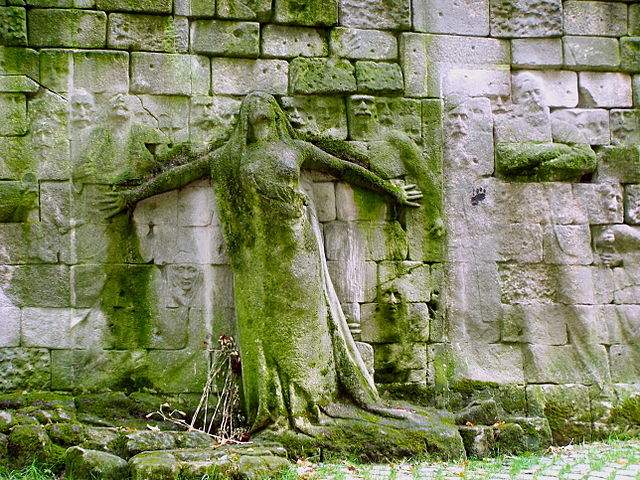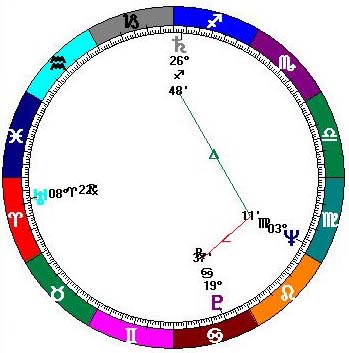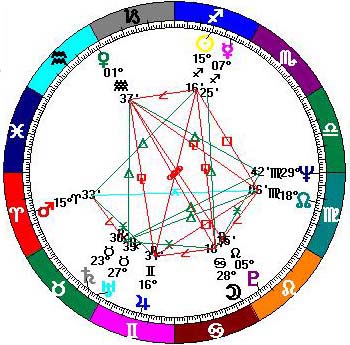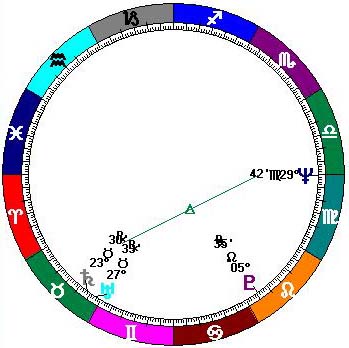
"Monument aux Victimes des
Revolutions" by
Paul-Moreau Vauthier.
From the tides of history,
the ghosts in
the stones.
Our last newsletter
described the
short-term switch we’re
currently undergoing between a recent period of angry and frustrating
grand
crosses and a more enthusiastic, rebounding time of grand trines. Both
are
temporary and fairly brief, however, and when it’s all said
and
done, will
there be any net progress at the end? The answer lies in the
relationship
between middle and long-term cycles.
“Which
side are
you on?” repeated the organizing anthem of the
Harlan County, Kentucky coal miners on strike against starvation wages
and
brutal conditions in 1931. They were fighting the odds, with big money
and
government in the other corner, but in the end, history was on their
side and
buried the ruthless bosses and their scabs in the dungheaps of the
past. Fifty
years before, that same cry from the Paris Commune was temporarily
silenced,
but ultimately changed history. They were uphill battles, but although
the
established powers were against them, the tide of society was moving
toward social democracy, fair wages and rights for the working man and
woman.
Those
tides come in
waves, however -- two steps forward,
one step back -- and sometimes it's hard to tell in which direction
ultimate
progress lies. There is a clue to be gained in the skies, and it comes
from
the relationship of Saturn and the outer planets – and the
reason
it’s hard to
find at first glance is because of the masking effects of Jupiter,
Mars,
and the
inner planets.
Saturn,
Outer Planets
Tell The Tale
The
basic idea is
simple. The general motion of history is
painted over the centuries by the slower movements of the outer
planets. Representing the greater sweep of religion, culture, and
technology, theirs is the
inexorable
effect that wears down monarchies, overthrows dictatorships, and
evolves
democracies, whatever the short-term successes that strut and fret
their parts
upon life’s stage. When we think of short-term success,
Jupiter
and its cycle
comes to mind, but that is only the aspiration to success, the growth
and drive
that gets you there, or gives you the illusion you’re getting
somewhere. It’s
Saturn and its cycle that represents true success – you
haven’t made it until
you’ve become the establishment, and that’s Saturn.
The
trouble is, Saturn can
be solid and supportive, or it can be harsh and repressive, and
sometimes you
can’t really tell the difference until you yourself have
helped
put the bad
version into power. Perhaps worse, at
other times you don’t know when you’ve got a good
thing
going and you help
throw out the baby with the bathwater.
There
are times when all the sky is truly a mystery, totally at
cross-purposes, or at the
still point of massive change, such as the late Edwardian period or the
1760s.
But such times are rare. Usually there’s a clear direction,
if
you know what to
look for.
November
11, 1918, 11:11 AM -- Armistice chart with clutter (l.) and
without (r.) -- Saturn breaks away from outer planets.
The
giveaway is whether
Saturn (establishment, government)
is running with or in opposition to the outer planets. Simple as that.
Because
of their relative speeds, the outer planets (OP) spend most of their
time
within a 180-degree arc, often within a 120-degree arc, with only
relatively
brief periods when Uranus is outside of it. If you take all the rest of
the
planets out of the chart, you see history developing itself in a cozy
OP nest
-- a bowl
or even a bundle
chart. Put back all the
other planets and you
hardly notice the effect, because they move around so fast and clutter
up the view.
Put back just one, Saturn,
and you see a rhythm of periods in history when Saturn is outside of
that bowl,
and much of that as the handle of a bucket chart. During these times,
the
establishment is bucking the tide of history. The majority of aspects
made by
Saturn are hard and conflicting, primarily because of the
preponderances of
squares, quincunxes, and oppositions. Conversely, when Saturn is within
that OP
nest, the additive trend of the aspects it makes is supportive, because
of the
preponderance of the conjunction, semi-sextile, sextile, and trine.
If
these were all you
had to deal with, you’d have already
noticed all this long ago. But it is not the habit of astrologers to be
so
semi-selective. It has been traditional to look at conjunction cycles
of one or
two planets as history-shapers. That concept has been around since
al-Kindi and
Abu Ma’shar and was shaped by Aristotle. But a tide,
historical
or otherwise,
is not a single event but a flow of events, and that is what you want
to look
for. When you throw all
the planets in, the self-cancelling
clutter of
the shorter-cycle planets obscures the mixed rhythms that Saturn and
the outer
planets make that both depict the shape of history and yet are still
within
a
single human lifespan, within the tangible range of human choice. In
other words, you can see which way progress lies -- even if it
isn’t popular, or
in power, or even appealing at the moment -- and you can take the right
side.
Perhaps “right” may too charged a word, but you can
take
the side of history
and progress, such as it is, for sure.
In And
Out Of The Nest
That’s
good in
theory, but how does it work out in real life?
Let’s look at notable, recent periods when Saturn was in or
out
of the bowl.
Saturn
was nested with the outer planets 1805-19, outlining the
Napoleonic Wars and the subsequent rearrangement of Europe, and also
1942-53,
outlining the war to contain fascism (WWII) and the subsequent
rearrangement of
Europe. Each of those was followed by
a
short nesting 1846-52 (revolutions across Europe) and 1982-89 (peaceful
revolutions and reestablishment of democracy in Eastern Europe). We get
another
large nest in 2020-33, but then things go haywire as the OP go into
grand trine
and prevent nesting, as they did in the period just before and during
the
American Revolution. Nesting is also pretty much prevented when the OP
go into
an opposition pattern, splitting the Zodiac, as they did in the late
19th
century. A brief glance might indicate that wars and social change that
mark
progress (or historic social change) are characteristic of the nesting
period,
but also that there are periods when the OP themselves are either
divided
(when you
get big rearrangements, but no forward motion, like the lead-up to and
conclusion of WWI) or in grand trine, when they're doing something
really
special on a much bigger canvas, part of the +/-500-year Neptune/Pluto
recurrence cycle.
Clearly,
what
we’re looking at is the really big hand of
time (the OP) in relation to the next smaller one, Saturn. When
Saturn’s in,
it’s progress, though sometimes at great cost – but
what
about when Saturn’s
out? It’s out most of the time, so that has limited meaning,
but
it would be at
its most noticeable when Saturn’s making a bucket with the
OP, or
at least
sixty degrees outside of their nest, which happens less frequently. Recently,
that’s been 1825-39
(repressive
European monarchies restored), 1858-77 (U.S. Civil War and
Reconstruction,
Franco-Prussian War), 1923-35 (rise of fascism), 1961-77(brackets
Vietnam War),
1998-2019 (???).
 
Stock
Market crash October 29, 1929 marked height of Saturn bucket,
Establishment bringing on disaster
So
far, only the most general periods and trends seem to be highlighted,
and then
not exactly. But suppose we fine-tune them a bit more. What we are
looking for
is crossover times when those in power changed from sailing with the
winds of
history to trying to fight them. The logical crossover point is when
Saturn is
not actually within the OP but beginning or ending a bowl with them
itself,
from its opposition to the leading edge OP until its opposition the
trailing
edge OP. Those are the points where the hard aspects really cut in and
the
helpful ones become rare, between the central periods of nesting or
bucket.
Then, on top of that, Jupiter and even briefer Mars cycles act to mask
or
distract from the overall motion, often triggering misplaced confidence
and
acts of war in the process.
Possibly
the best
example is the Great Depression and the
concomitant rise of fascism, particularly in Germany. It happened at
the
peak of
Saturn its bucket opposite the outer planets, but even as that waned,
Jupiter joined
Saturn in 1940 as if to support it, as did Mars just before at the
invasion of
Poland and the outbreak of war. Yet, Saturn was already moving away
from its outside status and towards the outer planets and the outcome
of the conflict was
already ahead of the trappings of its beginnings. At the time it was
happening, you
might have been hard-pressed to predict the winner, but watching the
rise of the perpetrators
could have told you that the very fact of their stars being in the
ascendance
(so to speak) doomed them to future defeat. Such, in fact, was the case
even
for some laudable steps forward elsewhere, such as NRA and much of the
stillborn socialism of FDR in America. After all, FDR came to power
only weeks
after Hitler did, and died just weeks before him. Establishment
victories in the late
1930s simply wouldn’t last, though their effects would endure
forever.
It
is beyond the scope of this article to apply this principle, example by
example, to the other periods of history we have mentioned, as that
would take
a book. Yet, a glance at the transits and the associated events, from
Napoleon
to the present, shows a consistency that bears closer inspection. If
you look
at just Saturn and the OP across a large swathe of history on a
computer,
speeded up so the years fly by on-screen, you can see a tide-like
rhythm that
looks like waves ever washing upon the shore, each time backing off and
then
going farther forward.
 
By the time of the Pearl
Harbor attack,
Saturn had finished its outside stint, and again rejoined the outer
planets.
When
the real swing from
one period to another occurs depends on just how
alone Saturn is in the sky. If Jupiter and Mars join it
against
the OP for a while, they can extend its regressive power, as happened
in the late 1930s, when it had already passed its opposition to Neptune
and was well beyond a bucket, but found Jupiter and Mars aggressively
taking over the bucket handle and prolonging the previous trends long
enough for the Nazi conquest of Europe and some serious doubts about
whether things would ultimately change direction. If you look at the
transitions into most
of the other
periods mentioned earlier, you'll find them to be
centered around when Saturn got past the bucket and into a bowl, but
before it actually nested, with some extra stretch or compression
provided by Jupiter and Mars either augmenting it or hastening the
change. Look for when Saturn makes the opposition to the leading outer
planet, forming a bowl, and there's your marker, the tipping point.
What
makes all this particularly
relevant right now is that we are
at just such a crossover period in the next couple of years, in which
Saturn
finally gets
out of the opposition to the OP and all the planets tighten up ranks,
beginning with a bowl in 2008-9 and moving on to a bundle
by 2019. As before, it may not be a peaceful
progression because of the fix we may already have found ourselves in
-- especially
since we
have two very strong Saturn buckets yet to get through in the winters
of 2007
and 2008. But
by that time you will probably know who the ultimate winners will
be.
So
you
are, by this, forewarned -- simply by looking at who’s in
power
now and what
they’re up to. Whoever they are and whatever
they’ve been
doing, it’s been
bucking the tide -- they've been up to no good, just because they
could. So, who
have you been voting
for, and now, which
side are you on?
And finally, a word from
our sponsors
[that’s us, no one
else!]:
Don’t
forget our
wonderful selection of astrological
reports --
they’re illuminating,
helpful all year long, they make great gifts -- and they're on sale
now! Our pick this month: DayWatch.
-- John
and Susan
Townley
Not
a
newsletter subscriber already? Subscribe
free here!
Tell us what you think! at: townley@astrococktail.com
|

